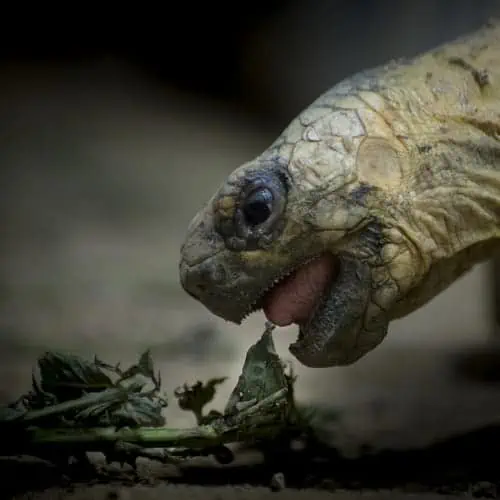
Turtles, tortoises, and terrapins make great pets due to their fairly peaceful nature. They are generally omnivorous, which means they can consume both meat and plants. Although their diets are influenced by their natural habitats, their bodies can assimilate nutrients from a wide variety of food choices. Many of these are frequently found in our own home kitchens and local supermarkets.
A healthy diet is crucial to successfully rear tortoises and turtles into old age. These reptiles are some of the most long-lived pets, with some species capable of outliving their owners. Mortalities at a young age are often attributed to improper feeding and inadequate housing conditions. Fruits and leafy greens, which are usually favored by these reptiles, may harbor toxic compounds that can cause serious harm. Even some vegetables that humans consume in cooked form can be harmful to turtles when ingested raw.
Plant toxins can harm turtles either internally or externally. Saps that contain sharp crystals may cause skin inflammations and rashes upon contact. These, along with toxic metabolites in plant cells, can cause oral and digestive issues when consumed. A large portion of the plant material is usually required for fatal symptoms, but it would be best to keep turtles and tortoises completely away from them. When in doubt, stick with plants that are well-known for being tortoise-friendly or consult your local veterinarian.
1) Asparagus fern (Asparagus aethiopicus or A. densiflorus)
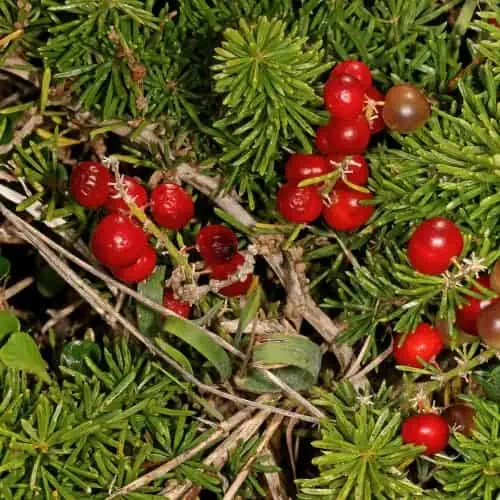
This species is frequently grown as an ornamental plant due to its fantastic sculptural features. Despite its common name, it isn’t actually related to true ferns. It is also commonly referred to as Sprenger’s asparagus, asparagus grass, and foxtail fern as its leaf-like features occur in whorls. The “leaves” are actually cladodes, which are flattened, modified, chlorophyll-containing shoots that grow out of the principal stems.
A. aethiopicus produces small clusters of pinkish-white flowers in spring. When pollinated, these develop into tiny red berries. At the base of the plant is a dense mat of highly fibrous roots along with tubers for water storage. Fragments of the crown and tubers may develop into complete plants and facilitate rapid expansion. As a result, this species is considered a troublesome weed or invasive species in some areas. Its cultivars are often reared in pots in indoor locations, especially in zones with cooler temperatures.
The toxic element of asparagus fern is largely concentrated in its berries. These contain saponins, steroids that can cause a dermal reaction and gastrointestinal complications. External reactions are usually short-lived but may become aggravated upon re-exposure. Depending on the amount ingested, toxicity symptoms can range in intensity from mild to severe. For peace of mind, keep this ornamental plant away from the turtle or tortoise enclosure.
2) Boxwood (Buxus sempervirens)
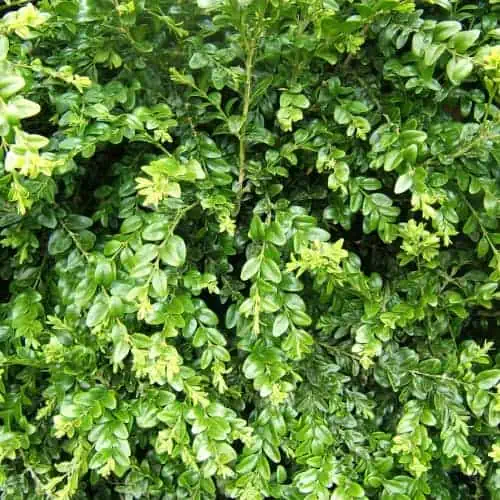
Commonly used as an evergreen hedge plant, boxwood is a highly textural shrub that can grow into a small tree (up to 30 feet tall) at maturity. Its densely occurring branches are often pruned into both organic and well-lined shapes. The yellow to bright green leaves occur in opposite pairs along potentially lengthy stems. The flowers, which are somewhat unremarkable as their colors resemble those of the leaves, are usually pollinated by insects. One of these, the box tree moth (Cydalima perspectalis), tends to spread with the plant.
The uses of boxwood extend far outside the topiary garden due to the quality of its wood and its wide variety of secondary metabolites. Its hardwood is extremely compact and heavy as it is notably slow-growing. It is often used in engravings and as a substitute for ivory. Its medicinal potential is also highlighted as the oils in both the leaves and the bark can treat a wide range of maladies, from malaria to HIV. In the past, herbalists would make decoctions to treat fever.
These same medicinal components are toxic when consumed incorrectly or in high doses. The combination of steroidal alkaloids and flavonoids in the leaves may damage both the gastrointestinal system and nervous system of turtles and tortoises. The primary toxins are alkaloids that may cause contact irritation and intoxication in both humans and animals.
3) Cursed crowfoot (Ranunculus sceleratus)
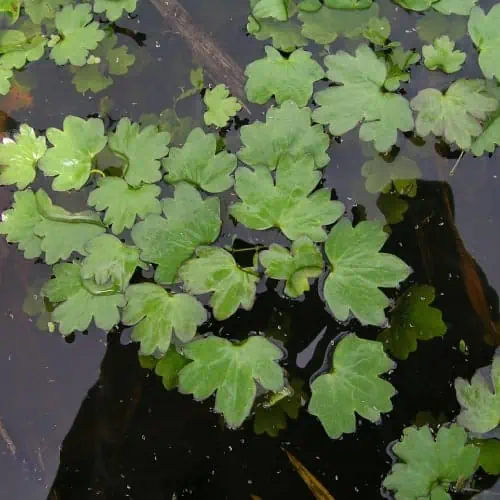
The modifier in this plant’s common name, cursed buttercup, directly alludes to its toxic profile. It is one of the most dangerous of all buttercup plants due to its high concentration of protoanemonin. This toxin is only produced when the plant’s components are mechanically destroyed. Wounding or macerating the leaves converts ranunculin, an unstable glucoside, into two byproducts – glucose and protoanemonin. Contact with this substance can cause blisters or rashes.
If an unsuspecting tortoise nibbles on the leaves of cursed crowfoot, it may suffer from dizziness and nausea. In the worst case, consumption of a large number of leaves can lead to hepatitis and paralysis. The plant’s bitter taste usually wards off any grazers, but captive reptiles may lack the instincts to avoid eating the poisonous juices. Wild animals that may browse on the young leaves tend to develop oral or digestive inflammation.
To identify cursed crowfoot, inspect the kidney-shaped leaves. They have shallow to deep, palmate lobes with bluntly-toothed margins. The basal and stem leaves have their own stalks and occur alternately along the main shoot. The small blooms, which have white to yellow petals, are borne on the tips of the flowering stems. If you have this plant in your garden, make sure to use gloves while handling any of its parts. Note that this species prefers to grow in moist areas with rich soil.
4) Lily of the Nile (Agapanthus africanus)
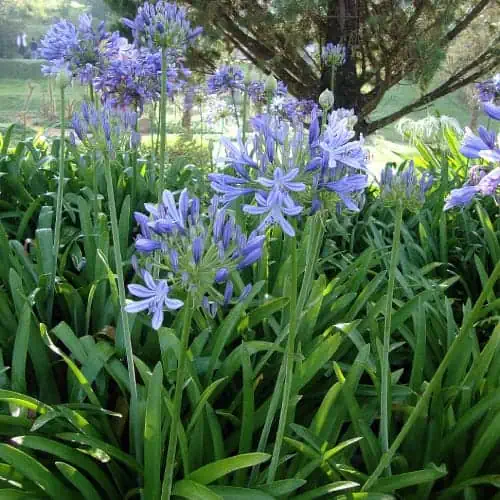
This charming plant’s common name is a bit of a misnomer as it isn’t native to any regions covered by the Nile River. In the Cape Peninsula, where its delicate blooms grace the sandstone slopes of natural shrublands, its fleshy roots are highly adaptable and can even survive through destructive fires. Also referred to as the African lily, this evergreen plant is often confused with the more popularly grown A. praecox, with which it shares its common name and many features.
Though the poisonous compounds are largely concentrated in the rhizomes and leaves, all parts of the lily of the Nile are toxic. The sticky sap can cause severe ulcers in the mouth and may induce diarrhea and abdominal pain in animals, but it is traditionally used as a medicine as well. Skin contact with wounded plant material can cause rashes that are accompanied by a burning sensation. If you intend to cultivate this species and any of its close relatives, make sure it is kept at a safe distance from areas where your pets are allowed to roam free.
Despite its toxic profile, lily of the Nile is a popular ornamental plant as its inflorescences can bring remarkable color to temperate gardens. Amazingly, in its native environment, its blooms are known for occurring more profusely after a fire. Their colors vary depending on the cultivar but are usually anywhere from pale to dark blue.
5) Pothos (Epipremnum aureum)
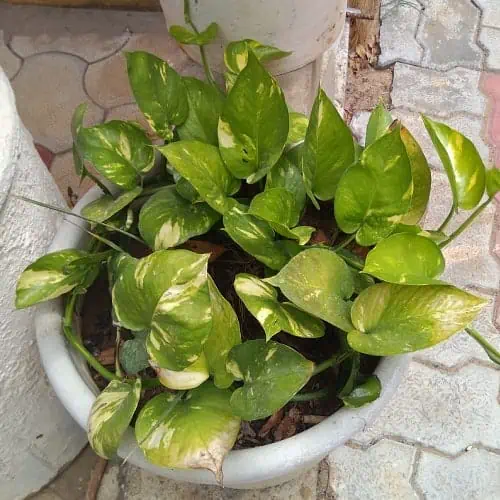
This perennial houseplant, which has become popular all across the globe, goes by many names. Distinguished by its creeping stems and speckled leaves, it also goes by devil’s ivy, silver vine, money plant, marble queen, and Ceylon creeper. It is now naturalized in many equatorial regions, where its dense colonies continue to expand in tropical to subtropical forests. Its capacity to spread via fragmentation has ecologically threatened many native plants.
A recipient of the RHS Award of Garden Merit, E. aureum is often grown in homes with young children and pets due to its ease of cultivation. Though it favors rich soil, it can even be grown in a glass of water or on the surface of an aquarium. It is so ubiquitous as a houseplant that most people are not at all aware of its toxic profile. The entire plant contains insoluble raphides, which are needle-like calcium oxalate crystals.
If turtles munch on and ingest the raphide-rich leaves, they may develop oral and digestive ailments. The same goes for other domestic pets, which are often more curious and eager to eat the leaves. Even humans can experience unfavorable symptoms, but this is usually restricted to contact dermatitis upon contact with damaged parts of the shoot and leaves. If you are determined to grow this beloved houseplant in a room that your pets visit, make sure it is placed in an inaccessible location. Cuttings should be disposed of properly.
6) Florist’s daisy (Chrysanthemum x morifolium)
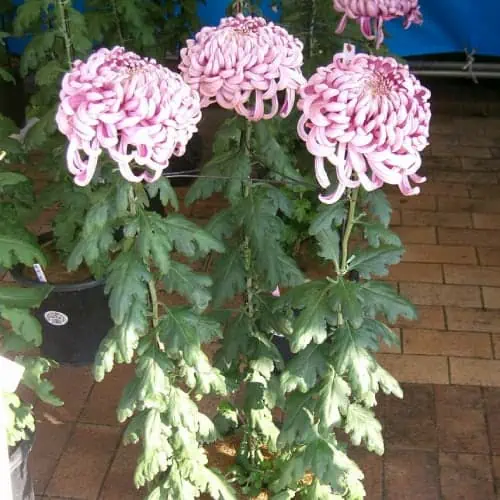
Chrysanthemums are extremely popular all across the world. These fantastic flowering plants are often used to create inviting displays along the facades of flower shops, dense flower beds in botanical gardens, and enchanting floats during flower festivals. Due to their popularity, horticulturists have been hybridizing them for hundreds of years in an effort to create a wider assortment of flowers and colors. Chrysanthemum x morifolium is one such hybrid that has resulted in dozens of florist’s variations.
This incredibly attractive plant, like many others, is unfortunately toxic when raw and should not be consumed by pets. Its potentially toxic compounds have medicinal benefits when the plant is prepared properly and the appropriate doses are used. The leaves contain irritant oils that may cause contact dermatitis. The main toxic component, alantolactone, can trigger digestive problems in tortoises and many larger animals.
Keep your chrysanthemums in pots that are safely distanced from animal enclosures or outdoor areas where your pets are allowed to roam free. If you regularly place chrysanthemum bouquets around the house, make sure the leaves don’t drift off to areas that are frequented by pets or children. Wounds with oozing sap will likely cause irritations, so the use of gloves is advisable whenever you must handle cuttings of your plant.
7) Sweet pea (Lathyrus odoratus)
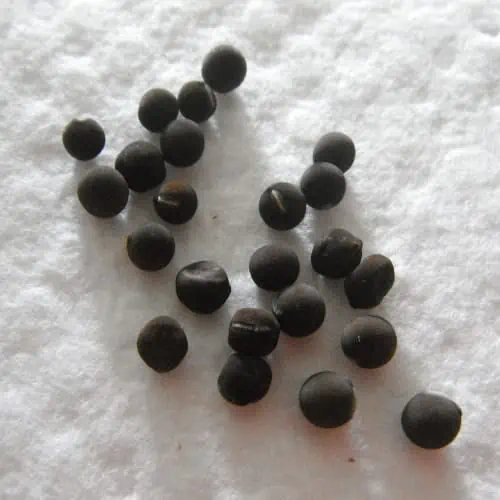
Sweet pea is an annual flowering plant with a creeping habit. It produces fine tendrils which can cling onto the structural features around them, allowing the plant to creep upwards or sideways to a length of about 1 – 2 meters. Horticulturists recommend removing the tendrils with a clean pair of gardening shears to encourage the stems to grow upright. The tendrils have the tendency to cling onto other plant parts as well, causing the stems to appear misshapen.
This species is often cultivated as an ornamental plant due to its fragrant, colorful flowers. These can begin to appear as early as spring in warmer climates and may last up to fall in cooler regions. Bloom colors vary according to cultivar, but the type variety usually produces purple flowers. When pollinated, they develop into pea pods. These pods are far from edible, however, as their seeds contain toxic compounds called lathyrogens.
Don’t confuse this plant with another edible species that goes by a similar and often identical common name, English pea (Pisum sativum). The mildly poisonous lathyrogen-rich seeds cause lathyrism, a condition marked by convulsions, paralysis, and difficulty breathing. If turtles consume the protein-rich seeds, they may unfortunately suffer from degenerative arthritis and organ system problems. Pea pods and legumes are generally bad for these reptiles and should not form any part of their diet.
8) String-of-pearls (Senecio rowleyanus)
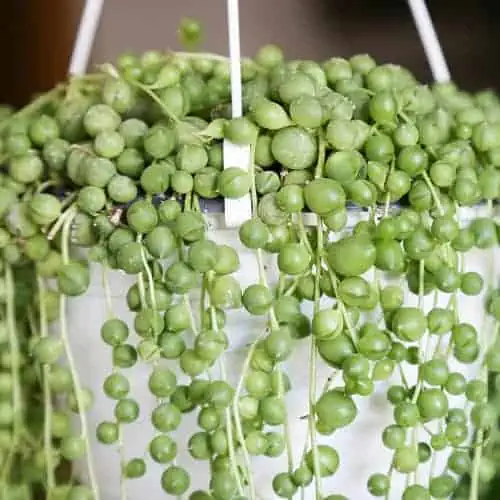
S. rowleyanus is a stunning ornamental succulent that is known for its unique leaf forms. The pulpy leaves are spherical enough to resemble pearls or beads. They are borne on fine, trailing stems that often creep outward from the crown of the plant and develop roots wherever they touch the ground. As a result, this species can produce highly textural mats on the ground. For ornamental purposes, it is often reared in hanging pots or baskets which allow the lightweight stems to gracefully cascade downwards.
All vegetative parts of string-of-pearls should not be consumed by humans or animals as they contain minor toxins. Both skin contact and ingestion with the plant’s sap may cause mild irritations. If ingested by animals, the sap may cause excessive salivation, vomiting, diarrhea, and lethargy. This species may look beautiful in a reptile enclosure, but that definitely isn’t the place for it as any fallen leaves may be feasted on by the unsuspecting critters.
9) Umbrella tree (Heptapleurum actinophyllum)

The umbrella tree is often cultivated as an ornamental plant in tropical and subtropical regions. It can be maintained as a medium-sized shrub or allowed to grow as large as a small tree. This rainforest plant is often found as a hemiepiphyte in the wild. This means that it can initially grow as an epiphyte once its seeds have germinated on the surfaces of trees. Over time, the roots make their way downwards until they come into contact with the ground, at which point they become rooted in the substrate.
In gardens and urban settings, the umbrella tree can grow perfectly fine on its own. Among its fantastic features are palmate leaves that are composed of 7 perfectly oblong and straight-margined leaflets. Its flowers appear in the thousands on inflorescences that are perched at the treetop. These produce a large amount of nectar, which attracts birds, marsupials, and bats throughout this species’ native distribution.
All parts of the plant, save its nectar, contain a cocktail of calcium oxalate crystals, saponins, and terpenoids. Ingestion of the leaves may result in vomiting, diarrhea, oral swelling, and digestive issues. Skin contact with the sap may also cause local irritations. The sharp, insoluble crystals may embed themselves in the tissues and organs of turtles, tortoises, and just about any other pet. Make sure this plant is fairly distanced from any animal enclosures or garden areas where pets are permitted to explore.

